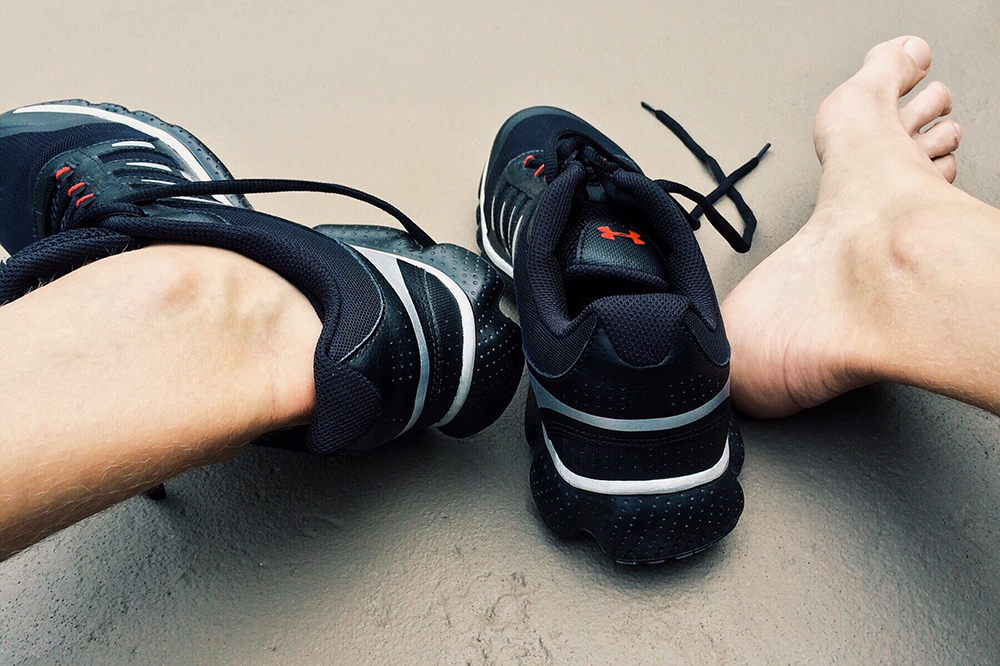 By Kate Zanoni, LPTA
By Kate Zanoni, LPTA
Wellness Blog Contributor
[twitter-follow screen_name=’@toCME4PT’]
(April 26, 2017) — Ouch! If you’ve ever had plantar fasciitis, you know just how excruciating those first few steps are when you get out of bed in the morning. It can feel like you’re stepping on a knife as the tight connective tissue on the bottom of your foot stretches out.
As someone who has had a recurrence of plantar fasciitis over the years, beginning in high school, I can tell you first hand just how painfully necessary it is to address the underlying cause to avoid flare-ups.
What Exactly is Plantar Fasciitis?
Plantar fasciitis occurs when the plantar fascia – or connective tissue along the bottom of your foot – gets tight, swollen and irritated. Plantar fascia is a flat band of ligamentous connective tissue that runs from your heel bone to your toes. It helps provide stability for the arch of your foot but can cause problems when it gets inflamed.
Plantar fasciitis is the most common cause of heel pain due to the insertion point of the plantar fascia along the calcaneus, or heel bone. Pain is also common in the arch of the foot and the ball of the foot where the fascia stretches to attach to bony prominences along the bottom of your mid-foot.
What Causes Plantar Fasciitis?
Plantar fasciitis commonly occurs in adolescent athletes, soldiers and the middle-aged population, who are often on their feet. Repeated strain on the plantar fascia leads to irritation and inflammation, causing pain with weight bearing, walking and running. Over time, repeated straining of the plantar fascia can cause microtears in the ligaments, leading to increased pain.
You are at an increased risk for developing plantar fasciitis if you:
- Have high arches or flat feet
- Are overweight
- Have ill-fitting shoes
- Frequently wear high heels
- Don’t use proper arch support
- Overpronate (your feet roll inward when you walk)
- Stand on hard surfaces for prolonged periods of time
- Run on unstable surfaces
- Have tight calf muscles or Achilles tendons
What Caused My Plantar Fasciitis?
My plantar fasciitis began in high school during preseason field hockey training. We were pulling two-a-day workouts and running on grass, asphalt and neighborhood sidewalks in our cleats. Arch support was an afterthought and more than half the team ended up with “fallen arches” due to overtraining and the increased stress of running on uneven surfaces.
Our athletic trainer stressed the importance of using arch support; yes, even in our cleats. She also educated us on the essentials of stretching, something we often overlooked during practice because we were so focused on running, drills and scrimmages.
Years later, I am now a proponent of arch support, and although I love wearing flip flops in the spring and summer, I know better. Flip flops do not provide the support I need, especially since I have extremely high arches.
Instead, I rotate over-the-counter inserts called Super Feet in all of my shoes: sneakers, gym shoes, winter boots and even my “fancy” dress boots. The arch supports I use help provide extra stability to accommodate for my high arches, redistributing the weight more evenly through my foot to reduce overpronation and improve my biomechanics.
Yes, ladies, I’ve had to hang up my high heels and trade them for “sensible shoes,” but my feet are much happier as a result. Trust me, happy feet are much more important than fashionable shoes.
Do I Need Custom Orthotics?
The answer is, most likely, no. Unless you have a structural abnormality, custom orthotics are typically unnecessary. Over-the-counter orthotics and arch support have come a long way over the years. Not only are they more affordable – typically available for $25-$60 per pair – but the technology behind them allows you to choose the correct type of arch support based on your arch height and foot shape using a simple chart.
If you have any questions about arch support, you can call our office to speak with a therapist who can analyze your gait pattern and foot shape. You can reach us Monday through Friday from 6:30 a.m. to 7:00 p.m. at 703.450.4300.
You can also go to your local running store or shoe store to have a specialist analyze your gait to fit you for the right type of arch support.
Custom orthotics can be great if you have a structural abnormality that requires them, but they are often cost prohibitive, running upwards of $200. All too often, they can be too rigid, causing overcorrection and increased pain for the general population.
Loosening Your Fascia
To help loosen the tight band of fascia on the bottom of your foot – which can feel like a thick rope or big marbles – roll your foot on a tennis ball, lacrosse ball or a frozen water bottle for a few minutes each day. Using a frozen water bottle gives you the added benefit of the ice’s natural anti-inflammatory properties, helping reduce the irritation in the tissues along the bottom of your foot. Yes, it will hurt. Yes, it’s worth the pain.
Consistent stretching is also vital to improve the tissue extensibility of your plantar fascia. As a therapist, I’m on my feet all day long. I use Super Feet arch supports in my sneakers and replace them every few months due to normal wear and tear, but if I don’t stretch my calves and roll my plantar fascia on a regular basis, I’ll definitely feel those sharp, stabbing pains when I get up in the morning. This is the ugly recurrent nature of plantar fasciitis. It can become a chronic problem if you don’t address the underlying issue and consistently stretch.
Stretches to Help Alleviate Some Soft Tissue Restrictions

Gastrocnemius Stretch: Your gastrocnemius is the largest, outer most calf muscle. It runs from your calcaneus (heel bone) to your femur (thigh bone). Since it crosses your knee joint, it’s important to keep your knee straight to isolate the muscle and reap the full benefits of the stretch. Stagger your feet into a lunge position and place your hands against a wall. Gently lunge forward, keeping your back foot on the ground, until you feel a stretch in the back of your calf. Hold the stretch for 30 seconds and repeat it three times.

Soleus Stretch: Your soleus is a smaller calf muscle that sits below and underneath your gastrocnemius. It runs from your calcaneus (heel bone) to your tibia (lower leg bone). Since it doesn’t cross your knee joint, it’s important to bend your knee to isolate the muscle. Stagger your feet into a lunge position, but shorten your lunge stance so that your feet are closer together. Gently bend both knees and lunge forward, keeping your back foot on the ground, until you feel a stretch in your lower calf. Hold the stretch for 30 seconds and repeat three times.

Plantar Fascia Stretch: Your plantar fascia runs from your calcaneus (heel bone) to your metatarsals (mid-foot bones just below your toes). To stretch your plantar fascia, sit in a cross-legged, figure four position and pull the ball of your foot and toes toward your shin bone until you feel a stretch in the bottom of your foot. If you aren’t flexible enough to cross your leg, you can perform this stretch by hanging your heels off the edge of a step. Hold this stretch for 30 seconds and repeat three times.
Note from our sponsor: If you suspect you have plantar fasciitis, call our office today to schedule an appointment with a physical therapist. We will teach you how to manage your symptoms with a home exercise program, relieve your pain with hands-on manual therapy and strengthen your foot intrinsic muscles and leg muscles to increase your stability and decrease your chances of having a recurrent flare-up. In the meantime, happy stretching!




